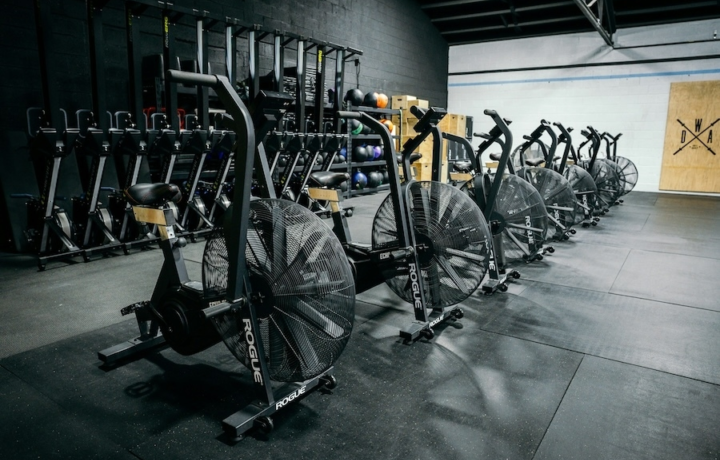Exercise
Running

Running
How to Perform
- Stand tall with your shoulders relaxed, core engaged, and feet hip-width apart.
- Begin with a slight forward lean from the ankles, keeping your head in line with your spine and gaze forward.
- Bend your arms at approximately 90 degrees, allowing them to swing naturally from your shoulders while keeping your hands relaxed.
- Push off the ground with the ball of your foot, rolling through to your toes for propulsion as you exhale during the effort.
- Land softly on your midfoot or forefoot, allowing your heel to touch down briefly while inhaling during this recovery phase.
- Maintain a cadence of 170-180 steps per minute by taking quick, light steps rather than long strides.
- Keep your pelvis neutral and core engaged throughout to stabilize your torso and prevent excessive rotation.
- Drive your knees forward rather than lifting them high, focusing on a slight backward kick to propel yourself forward efficiently.
Important information
- Keep your shoulders down and away from your ears to prevent tension in your upper body.
- Make sure your foot lands under your center of gravity, not in front of your body, to reduce impact forces.
- Maintain a relaxed facial expression and jaw to prevent unnecessary tension that can travel down your body.
- Breathe rhythmically using both your nose and mouth to maximize oxygen intake during longer runs.

Running
Exercise Details
Primary Muscles
Muscle Groups
Mechanic
Risk Areas
Built for progress
Take the guesswork out of training
Create personalized AI-powered workout plans that evolve with you. Train smarter, track every rep and keep moving forward, one workout at a time.






Running is an accessible, foundational form of cardio that's perfect for beginners looking to build their fitness base without complex equipment or techniques. This natural movement engages multiple muscle groups simultaneously, with your quads powering you forward, hamstrings controlling your stride, and calves providing the spring in your step. Your core muscles also activate to maintain proper posture and balance throughout your run, making it a surprisingly effective workout for your abs. The beauty of running lies in its versatility. For beginners, starting with alternating walking and jogging intervals builds endurance without overwhelming your cardiovascular system or muscles.
As your fitness improves, you can gradually increase your running duration and intensity at your own pace. Running can be incorporated into various training styles to achieve different fitness goals. Use it as a warm-up with a light 5-10 minute jog to increase your heart rate and prepare your muscles for more intense activity. For HIIT workouts, alternate between sprints and recovery jogs to maximize calorie burn and improve both aerobic and anaerobic fitness. During recovery days, a slow, gentle run helps increase blood flow to muscles without adding stress, promoting faster healing after intense training sessions. The endurance benefits of running are unmatched, gradually strengthening your heart, expanding lung capacity, and improving your body's efficiency in using oxygen. Regular running sessions build cardiovascular health by reducing resting heart rate and blood pressure while increasing your VO2 max: your body's ability to utilize oxygen during exercise. Consistency is key with running.
Even short, regular sessions deliver more benefits than occasional long runs. Listen to your body, progress at your own pace, and enjoy the mental clarity that often accompanies this rhythmic, meditative form of exercise. Many beginners find that running becomes less about the physical challenge and more about the psychological benefits, the coveted "runner's high" that keeps them coming back for more.
FAQ - Running
Running primarily engages your lower body (quads, hamstrings, and calves) while also activating your core muscles for stability and posture maintenance. Your glutes, hip flexors, and even upper body muscles provide supporting roles during proper running form.
Start with a walk-run approach, alternating 1-2 minutes of jogging with 2-3 minutes of walking for 20-30 minutes total. Gradually increase your running intervals while decreasing walking time as your fitness improves, and always include a 5-minute walking warm-up and cool-down.
For beginners, aim for 3-4 running sessions per week with rest days in between to allow for recovery. More experienced runners can increase to 4-6 sessions weekly, but always include at least one complete rest day to prevent overtraining and reduce injury risk.
Avoid overstriding (landing with your foot too far ahead of your body), hunching your shoulders, or excessive heel striking. Instead, land mid-foot with your foot under your body, maintain a slight forward lean from the ankles, and keep your shoulders relaxed with arms bent at approximately 90 degrees.
Increase your mileage gradually (no more than 10% per week), wear properly fitted running shoes, run on varied surfaces to distribute impact forces differently, and incorporate strength training for your legs and core twice weekly to improve muscular support around joints.









